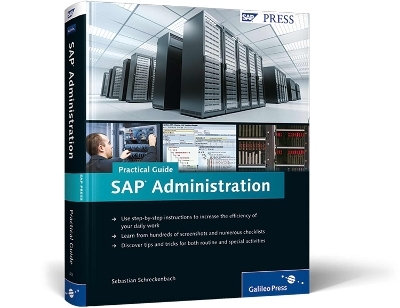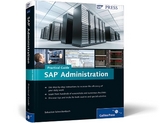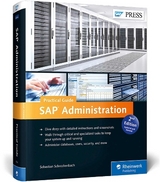SAP Administration - Practical Guide
- Titel ist leider vergriffen;
keine Neuauflage - Artikel merken
This enables you to easily understand the processes and reproduce them in your system. Checklists, Transactions, Forms, and More Download all checklists for critical tasks or for a security strategy from the book. The appendices also contain helpful lists with transactions and tables, as well as predefined forms.
Sebastian Schreckenbach works as a senior consultant for SAP Basis Technologies at Steria Mummert Consulting AG. Prior to this position, he spent many years as an SAP Basis administrator for the city administration of Dresden, the capital of Saxony, Germany.
Introduction 17
1 Fundamentals of SAP System Administration 23
1.1 Tasks of a System Administrator 23
1.2 Guiding Principles for System Administrators 25
1.3 Definitions 32
1.4 Summary 34
2 SAP System Administration 35
2.1 Starting and Stopping the SAP System 35
2.1.1 Starting the SAP System 36
2.1.2 Stopping the SAP System 41
2.2 Instances and Operation Modes 46
2.3 Maintaining Profile Parameters 62
2.4 Specific Monitoring Transactions 70
2.4.1 System Log 70
2.4.2 ABAP Dump Analysis 73
2.4.3 Checking the Application Servers and Work Processes 77
2.4.4 Lock Entries 80
2.4.5 Canceled Update Requests 83
2.5 System Messages 87
2.6 Connections 89
2.6.1 RFC Destinations 90
2.6.2 SAP Gateway Monitor 97
2.6.3 SAPconnect 99
2.6.4 Message Server Monitor 103
2.6.5 Internet Communication Framework 104
2.6.6 ICM Monitor 108
2.7 Client Administration 109
2.7.1 Creating Clients 110
2.7.2 Copying Clients 114
2.7.3 Deleting Clients 129
2.7.4 Checking the Client Copy Log 132
2.8 System Copy 133
2.8.1 Database Copy of the Production System 134
2.8.2 Client Copy with Data 135
2.8.3 Client Copy without Data 135
2.9 Summary 136
3 System Monitoring 137
3.1 The CCMS Alert Monitor 137
3.2 System Monitoring with the Standard CCMS Alert Monitor 138
3.3 Adapting the CCMS Monitor Sets 148
3.3.1 Hiding Monitor Sets 148
3.3.2 Defining a New Monitor Set 153
3.3.3 Adding a Monitor to a Monitor Set 156
3.3.4 Deleting a Monitor from a Monitor Set 159
3.3.5 Changing Alert Threshold Values 163
3.4 Auto-Reaction Methods 167
3.4.1 Changing an Auto-Reaction Method 168
3.4.2 Assigning an Auto-Reaction Method to a Monitor Object 173
3.5 Summary 178
4 System Administration with SAP Solution Manager 179
4.1 Functional Spectrum of SAP Solution Manager 179
4.2 Maintaining the System Landscape 181
4.2.1 Creating a Server 182
4.2.2 Creating a Database 184
4.2.3 Creating a System 186
4.3 Solutions 201
4.3.1 Creating a Solution 202
4.3.2 Activating and Deactivating Solutions 206
4.3.3 Self-Diagnosis 208
4.4 System Administration 211
4.4.1 Central System Administration 211
4.4.2 Central System Monitoring 227
4.4.3 SAP EarlyWatch Alert 240
4.5 Maintenance Optimizer 256
4.6 Summary 268
5 Scheduled Tasks 269
5.1 Critical Tasks 270
5.1.1 Check Whether the SAP System Is Running 270
5.1.2 Checks to Determine Whether Your Backups Have Been Successful 270
5.2 Daily Tasks 274
5.2.1 Critical Tasks 274
5.2.2 SAP System 275
5.2.3 Database 277
5.2.4 Operating System 277
5.2.5 Other 278
5.3 Weekly Tasks 278
5.3.1 SAP System 278
5.3.2 Database 279
5.3.3 Operating System 279
5.3.4 Other 280
5.3.5 Overview of Transactions 280
5.4 Monthly Tasks 281
5.4.1 SAP System, Database, Operating System, Other 281
5.4.2 Checking Consumable Items 283
5.5 Quarterly Tasks 284
5.5.1 SAP System 284
5.5.2 Database 285
5.5.3 Operating System 286
5.5.4 Other 286
5.6 Annual Tasks 287
5.6.1 SAP System 287
5.6.2 Database 288
5.6.3 Operating System 289
5.6.4 Other 289
5.6.5 Overview of Transactions 289
5.7 Summary 292
6 Backup and Restore 293
6.1 Backup 293
6.1.1 What Has to Be Saved? 294
6.1.2 Backup Types 298
6.1.3 Backup Strategy 304
6.1.4 Strategy Recommendations 305
6.2 Restore 308
6.3 Performance 310
6.3.1 Performance Factors 310
6.3.2 Backup Performance 311
6.3.3 Restore Performance 313
6.4 Summary 314
7 Disaster Recovery 315
7.1 Preliminary Considerations 315
7.2 Planning for an Emergency 317
7.2.1 Which Measures Apply to Disaster Recovery? 317
7.2.2 When Should the Disaster Recovery Procedure Begin? 318
7.2.3 Expected Downtime 319
7.2.4 Restore Time 320
7.2.5 Communication in the Event of a Disaster 320
7.3 Recovery Team and Role Distribution 321
7.4 Types of Disaster Recovery 323
7.5 Emergency Scenarios 323
7.5.1 Damaged Database 324
7.5.2 Hardware Failure 324
7.5.3 Complete Loss or Destruction of the Server Facility 325
7.6 Recovery Script 327
7.7 Crash Kit 329
7.8 Testing the Disaster Recovery Procedure 333
7.9 Minimizing the Risk of Failure 335
7.9.1 Minimizing the Risk of Human Error 335
7.9.2 Minimizing Single Points of Failure 335
7.10 Continuing Business During a System Recovery 336
7.11 Summary 337
8 Database Administration 339
8.1 Planning Database Administration Tasks 340
8.1.1 Planning Database Tasks 340
8.1.2 Changing and Deleting Database Tasks 344
8.1.3 Checking the DBA Planning Calendar 347
8.2 Checking Database Actions 350
8.3 Performing a Database Analysis 352
8.4 Monitoring Database Performance 359
8.5 Database Administration DB2 363
8.5.1 DB2 Command Line Processor 364
8.5.2 Starting and Stopping the Database 367
8.5.3 Executing SQL Statements 368
8.5.4 Updating and Checking the Database Manager Configuration 369
8.5.5 Updating and Checking the Database Configuration 371
8.5.6 Managing Tablespaces and Associated Containers 372
8.5.7 Backing Up the Database 375
8.5.8 Restoring the Database 377
8.6 Database Administration Oracle 379
8.6.1 SQL*Plus 379
8.6.2 Starting and Stopping the Database 382
8.6.3 Executing SQL Statements and SQL Scripts 387
8.6.4 Managing the Database 389
8.6.5 BR*Tools 389
8.6.6 Checking and Changing the Status of the Database Instance 391
8.6.7 Checking and Updating the Database Configuration 393
8.6.8 Managing Tablespaces and Associated Data Files 396
8.6.9 Backing Up the Database 400
8.6.10 Restoring the Database 404
8.6.11 Checking the Database 407
8.7 Database Administration Microsoft SQL Server 410
8.7.1 SQL Management Studio 411
8.7.2 Starting and Stopping the Database 413
8.7.3 Files and Logs 416
8.7.4 Initiating a Backup Process 422
8.7.5 Setting Up Maintenance Plans for a Backup 425
8.7.6 Backing Up System Databases 431
8.7.7 SQL Server Logs 434
8.8 Database Administration MaxDB 435
8.8.1 Database Studio 435
8.8.2 Starting and Stopping the Database 436
8.8.3 Database Monitoring 438
8.8.4 Backing Up the Database 443
8.9 Summary 447
9 Operating System Administration 449
9.1 Checking the Memory Usage of the File System 449
9.1.1 Monitoring the File System Using the CCMS Alert Monitor 450
9.1.2 Changing Alert Thresholds 452
9.1.3 Releasing Memory at the Operating System Level 454
9.2 Retrieving Operating System Information 458
9.3 Summary 464
10 Security Administration 465
10.1 What Is Security? 466
10.1.1 Protecting Data Against Damage or Loss 466
10.1.2 Adhering to Legal or Quasi-Legal Provisions 466
10.2 Security Levels 467
10.2.1 Access Security 467
10.2.2 Operational Security 469
10.2.3 Data Security 470
10.3 Safeguarding the SAP System 471
10.3.1 Preventing Multiple User Logons 472
10.3.2 Passwords 473
10.3.3 Limiting Access for SAP* or DDIC Users 477
10.3.4 Locking Critical Transactions 477
10.3.5 Preventing Changes in the Production System 480
10.3.6 Operational Security 486
10.4 Audits 487
10.4.1 Auditing Aspects 488
10.4.2 Auditing Tasks for SAP Administrators 489
10.5 Auditing Tools 491
10.5.1 Audit Information System 491
10.5.2 Security Audit Log 493
10.6 Summary 507
11 Performance 509
11.1 Short-Term Remedy of Performance Problems 509
11.2 Detailed Analysis of Performance Problems 514
11.2.1 System Load Analysis 515
11.2.2 Buffer Analysis 520
11.2.3 Memory Defragmentation 522
11.3 Analysis at Other Levels 523
11.3.1 Analysis at the Database Level 523
11.3.2 Analysis at the Operating System Level 523
11.3.3 Analysis at the Hardware Level 523
11.4 Summary 524
12 SAP GUI 525
12.1 Installation Requirements 525
12.1.1 Minimum Requirements for the User s PC 525
12.1.2 Network Functions 526
12.2 Installation Scenarios 526
12.2.1 Installing SAP GUI from an Installation Medium 527
12.2.2 Installing SAP GUI from an Installation Server 530
12.3 Adding Systems to SAP Logon 547
12.4 Summary 550
13 User Administration 551
13.1 General 551
13.2 Setting Up New Users 554
13.2.1 Copying Existing Users 554
13.2.2 Creating a New User 562
13.3 Maintaining Users 563
13.4 Mass Changes 563
13.5 Resetting the Password 566
13.6 Locking or Unlocking a User 568
13.7 Central User Administration 571
13.7.1 Setting Up a Central User Administration 571
13.7.2 Creating and Maintaining Users Via a Central User Administration 592
13.7.3 Troubleshooting 596
13.7.4 Deactivating or Deleting a Central User Administration 599
13.8 User Groups 608
13.9 Deleting User Sessions 610
13.9.1 Displaying Active Users 610
13.9.2 Deleting User Session 612
13.10 System Administration 613
13.10.1 Special User IDs 613
13.10.2 Special Authorizations 614
13.10.3 User Passwords 615
13.11 Summary 616
14 Authorization Management 617
14.1 Authorization Check Process 618
14.2 Authorization Roles 618
14.2.1 Creating and Maintaining Single Roles 619
14.2.2 Creating and Maintaining Composite Roles 629
14.3 Authorization Profiles 636
14.4 Utilities for Authorization Management 640
14.4.1 Default Values and Check Indicators 640
14.4.2 Authorization Trace 645
14.4.3 Infosystem Authorizations 650
14.5 Summary 652
15 Background Processing 653
15.1 Creating Background Jobs 653
15.1.1 General 654
15.1.2 Creating and Scheduling Background Jobs 655
15.2 Monitoring Background Jobs 662
15.3 Graphical Job Scheduling Monitor 665
15.4 Performance Factors for Background Jobs 666
15.5 Summary 669
16 Output Management 671
16.1 Setting Up the Spool Servers 671
16.2 Setting up Printers 675
16.2.1 Configuring Network Printers 675
16.2.2 Setting up Frontend Printers 681
16.2.3 Transporting Output Devices 684
16.3 Outputting Data 686
16.4 Output Control 688
16.5 Deleting Old Spool Requests 695
16.6 Checking the Spool Consistency 696
16.7 Checking the TemSe Consistency 697
16.8 Summary 699
17 Change and Transport Management 701
17.1 General Notes on Change Management 702
17.2 Transporting Objects 704
17.2.1 Creating a Transport Request 705
17.2.2 Recording Changes in a Transport Request 708
17.2.3 Releasing a Transport Request 710
17.2.4 Importing Transport Requests 713
17.2.5 Checking the Transport Log 719
17.3 Direct Table Maintenance 721
17.4 Summary 725
18 System Maintenance 727
18.1 Downloading SAP Support Packages 728
18.1.1 Determining the System s Current Support Package Level 729
18.1.2 Finding Support Packages 734
18.1.3 Downloading Support Packages 748
18.2 Important Notes on Preparing and Executing System Maintenance 751
18.3 Performing a Kernel Update 752
18.3.1 Kernel Backup 753
18.3.2 Unpacking a New Kernel 753
18.3.3 Stopping the SAP System 755
18.3.4 Replacing Kernel Files 755
18.3.5 Starting the SAP System and Checking the Logs 756
18.4 Applying the SPAM/SAINT Update 757
18.5 Importing ABAP Support Packages 761
18.5.1 Making the Support Packages Available 762
18.5.2 Importing the Support Packages 766
18.5.3 Performing a Modification Adjustment 778
18.5.4 Regenerating Objects 779
18.5.5 Performing Regression Tests 783
18.6 Installing Add-Ons 783
18.7 Summary 789
19 Diagnostics and Troubleshooting 791
19.1 Basic Procedure 791
19.2 Troubleshooting with the SAP Support Portal 794
19.2.1 Searching for SAP Notes with the SAP Support Portal 795
19.2.2 Customer Messages 798
19.3 Creating a Remote Service Connection 819
19.4 Implementing SAP Notes 828
19.4.1 Checking the System Patch Level 830
19.4.2 Implementing SAP Notes with the Note Assistant 832
19.5 Summary 836
Appendices 837
A Useful Transactions 839
B Security-Relevant Transactions 845
C Useful Tables 851
D Forms 855
E Bibliography 861
F The Author 863
Index 865
| Erscheint lt. Verlag | 30.4.2011 |
|---|---|
| Reihe/Serie | SAP Press |
| Verlagsort | Maryland |
| Sprache | englisch |
| Einbandart | gebunden |
| Themenwelt | Mathematik / Informatik ► Informatik ► Netzwerke |
| Mathematik / Informatik ► Informatik ► Programmiersprachen / -werkzeuge | |
| Informatik ► Weitere Themen ► SAP | |
| Schlagworte | ABAP • Administration • SAP NetWeaver |
| ISBN-10 | 1-59229-383-2 / 1592293832 |
| ISBN-13 | 978-1-59229-383-4 / 9781592293834 |
| Zustand | Neuware |
| Informationen gemäß Produktsicherheitsverordnung (GPSR) | |
| Haben Sie eine Frage zum Produkt? |
aus dem Bereich





